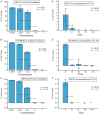Antineoplastic activity of povidone-iodine on different mesothelioma cell lines: results of in vitro study
- PMID: 24394552
- PMCID: PMC4038782
- DOI: 10.1093/ejcts/ezt534
Antineoplastic activity of povidone-iodine on different mesothelioma cell lines: results of in vitro study
Abstract
Objective: Povidone-iodine (PVP-I) or Betadine, owing to its antineoplastic activity, is also used as an adjuvant during intra-abdominal or intrathoracic surgery. However, the protocol of PVP-I administration has not been optimized to achieve the best antitumoural efficacy. We aimed to determine the optimal concentration of PVP-I, the time of incubation and the mechanism of cell death by analysing the effect of different doses and time of administration of PVP-I on the cell viability of different mesothelioma cell lines.
Methods: Four different cell lines (MET 5A/normal mesothelium; H2052/sarcomatoid mesothelioma; ISTMES2/epithelial mesothelioma; MSTO/biphasic mesothelioma) were incubated with increasing concentrations of diluted PVP-I (0.0001; 0.001; 0.01; 0.1; 1%) for 5, 10, 30, 60 min and 24 h, respectively. Cell viability was determined using cell direct cytotoxicity assay and cell death was determined through flow cytometry assay analysis. The superoxide dismutase activity was assessed functionally through a specific inhibitor to evaluate the mechanism of cell death.
Results: The antiproliferative effect of PVP-I varied largely among different cell lines in a dose- and time-dependent manner. At 0.1% concentration for 10 min of incubation, the percentage of viable cells was 0.5 ± 0.1; 0.8 ± 0.5 and 0% (P < 0.01) for MET5A, ISTMES2 and MSTO, respectively. Conversely, the same concentration did not significantly affect the H2052 cell line which was completely suppressed at a 1% concentration of PVP-I. Double staining of Annexin V and DNA showed that PVP-I induced cell death in all four cell lines via necrosis depending on PVP-I concentration. However, H2052 was found to be more resistant than MSTO, ISTMES2 and MET 5A cells lines. The activity of superoxide dismutase was significantly inhibited in all cell lines.
Conclusions: Our results confirmed the anti-neoplastic activity of PVP-I especially on ISTMES2 and MSTO cell lines. With respect to chemotherapy pleural irrigation, washing with PVP-I is cost-effective and easy. If confirmed by larger studies, our findings suggest that the intrapleural irrigation with PVP-I (0.1% concentration for 10 min) in patients with epithelial or biphasic mesothelioma undergoing cytoreductive surgery might be applied in thoracic surgery practice to prevent neoplastic cell growth.
Keywords: Betadine; Mesothelioma; Povidone-iodide.
© The Author 2014. Published by Oxford University Press on behalf of the European Association for Cardio-Thoracic Surgery. All rights reserved.
Figures





References
-
- Ried M, Potzger T, Braune N, Neu R, Zausig Y, Schalke B, et al. Cytoreductive surgery and hyperthermic intrathoracic chemotherapy perfusion for malignant pleural tumours: perioperative management and clinical experience. Eur J Cardiothorac Surg. 2013;43:801–7. - PubMed
-
- Lee JD, Perez S, Wang HJ, Figlin RA, Holmes EC. Intrapleural chemotherapy for patients with incompletely resected malignant mesothelioma: the UCLA experience. J Surg Oncol. 1995;60:262–7. - PubMed
-
- Bryan JL, Cohran J, Larson EL. Hand washing: a ritual revisited. Crit Care Nurs Clin North Am. 1995;7:617–25. - PubMed
MeSH terms
Substances
LinkOut - more resources
Full Text Sources
Other Literature Sources
Medical
Miscellaneous

